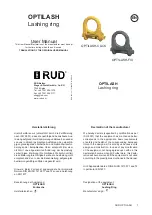
6
RUD OPTILASH
Load range:
Attach-
ment
permissible
Permissible
load range
Prohibited
load range
Prohibited
load range
180°
Permissible
load range
Prohibited
load
range
Prohibited
load
range
Fig. 20: Load range
• After use, move the lashing ring into its storage
position (cf. Fig. 15)!
4 Inspection / repair
4.1 Notes on regular inspection
The operator must determine and specify the nature
and scope of the required inspections as well as the
terms of periodic inspections by means of a risk as-
sessment (see sections 4.2 and 4.3).
The continuous suitability of the lifting equipment must
be checked at least 1x year by an expert.
Depending on the application conditions, e.g. when
used frequently or if there is a higher level of wear or
corrosion, it may be necessary to carry out inspec-
tions at intervals of less than a year. This inspection is
also absolutely necessary after damage and special
incidents.
4.2 Test criteria for the regular visual
inspection by the user
• Lashing point is complete
• Complete, legible lashing capacity information and
manufacturer symbol
• Deformation on supporting parts such as basic
housing and lashing ring
• Mechanical damage such as large notches, in
particular in areas subject to tensile loads.
4.3 Additional test criteria for the expert /
repairer:
• Cross-section changes due to wear > 10 % (see
wear markings)
• Heavy corrosion (pitting corrosion)
• Mobility of the bolt on the OPTILASH-CLICK.
Remove the OPTILASH-CLICK lashing ring from
its seat and check the mobility of the bolt (press
the bolt in completely and then let it go. The bolt
must return to its final position automatically). If
necessary, oil the bolt with penetration oil.
• Additional inspections may be necessary, depend-
ing on the result of the risk assessment (e.g. check
for cracks in load-bearing parts).

























